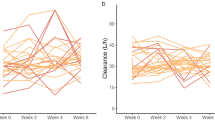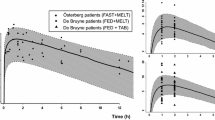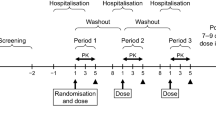Abstract
Introduction
Body position may influence physiological characteristics, such as perfusion, gastrointestinal function and plasma volume. These characteristics may interact with key factors determining the pharmacokinetics of drugs (dissolution, absorption, distribution, metabolism, excretion).
Objectives
Based on a systematic literature search, current data on the effect of posture on physiological characteristics and/or pharmacokinetics are summarized, and the relevance of possible effects, such as those presenting in clinical practice and clinical pharmacokinetic studies, is assessed.
Results
Postures which favour rapid gastric emptying (sitting, standing, recumbent right) accelerate the absorption of orally administered drugs. Consequently, these postures favour a shorter time to reach peak plasma drug concentration (tmax) and a higher maximum plasma drug concentration (Cmax) and—in the case of transient saturation of first-pass metabolism—total exposure (area under the concentration–time curve, AUC) in comparison to recumbent left and supine positions (e.g. nifedipine: AUC 30 and 38% higher in standing and right lateral position vs. left lateral position; Cmax 149 and 80% higher, respectively). The magnitude of these postural effects depends strongly on the nature and amount of liquids and food ingested before drug administration and is most pronounced in the fasting state and after administration with a nonnutrient liquid. Changes in splanchnic–hepatic blood flow (e.g. reduction of estimated hepatic perfusion by 37% in standing vs. supine position) may substantially affect the metabolism of orally administered drugs, especially of those with a high/saturable first-pass metabolism. For highly protein-bound drugs (e.g. phenytoin, imipramine), the total plasma concentration has been found to be approximately 10% higher in standing than lying subjects due to changes in plasma volume.
Conclusions
Positioning of a patient may be an effective method of enhancing or retarding absorption of some drugs in appropriate clinical situations (e.g. toxic ingestions, bedridden patients). In clinical pharmacokinetic trials, such as bioequivalence studies, defining and maintaining posture precisely is a useful approach for reducing within- and between-subject variability.
Similar content being viewed by others
References
Oosterhuis B, Jonkman JH (1993) Pharmacokinetic studies in healthy volunteers in the context of in vitro/in vivo correlations. Eur J Drug Metab Pharmacokinet 18(1):19–30
Anvari M, Horowitz M, Fraser R, Maddox A, Myers J, Dent J et al (1995) Effects of posture on gastric emptying of nonnutrient liquids and antropyloroduodenal motility. Am J Physiol 268(5):G868–G871
Golub AL, Frost RW, Betlach CJ, Gonzalez MA (1986) Physiologic considerations in drug absorption from the gastrointestinal tract. J Allergy Clin Immunol 78(4):689–694
Horowitz M, Jones K, Edelbroek MA, Smout AJ, Read NW (1993) The effect of posture on gastric emptying and intragastric distribution of oil and aqueous meal components and appetite. Gastroenterology 105(2):382–390
Burn-Murdoch R, Fisher MA, Hunt JN (1980) Does lying on the right side increase the rate of gastric emptying? J Physiol 302:395–398
Hunt JN, Knox MT, Oginski A (1965) The effect of gravity on gastric emptying with various test meals. J Physiol 178:92–97
Jones KL, O’Donovan D, Horowitz M, Russo A, Lei Y, Hausken T (2006) Effects of posture on gastric emptying, transpyloric flow, and hunger after a glucose drink in healthy humans. Dig Dis Sci 51(8):1331–1338
Moore JG, Datz FL, Christian PE, Greenberg E, Alazraki N (1988) Effect of body posture on radionuclide measurements of gastric emptying. Dig Dis Sci 33(12):1592–1595
Asada T, Sako Y, Fukushima Y, Kita T, Miyake T (1989) Effect of body position on gastric emptying of solid food–a study using a sulfamethizole capsule food method. Nippon Shokakibyo Gakkai Zasshi 86(8):1604–1610
Doran S, Jones KL, Andrews JM, Horowitz M (1998) Effects of meal volume and posture on gastric emptying of solids and appetite. Am J Physiol 275(5):R1712–R1718
Mannell A, Esser JD (1984) Gastric emptying of a solid meal. S Afr Med J 66(10):374–376
Spiegel TA, Fried H, Hubert CD, Peikin SR, Siegel JA, Zeiger LS (2000) Effects of posture on gastric emptying and satiety ratings after a nutritive liquid and solid meal. Am J Physiol Regul Integr Comp Physiol 279(2):R684–R694
Carney BI, Jones KL, Horowitz M, Sun WM, Penagini R, Meyer JH (1995) Gastric emptying of oil and aqueous meal components in pancreatic insufficiency: effects of posture and on appetite. Am J Physiol 268(6):G925–G32
Davis SS, Hardy JG, Fara JW (1986) Transit of pharmaceutical dosage forms through the small intestine. Gut 27(8):886–892
Heading RC, Nimmo J, Prescott LF, Tothill P (1973) The dependence of paracetamol absorption on the rate of gastric emptying. Br J Pharmacol 47(2):415–421
Backon J, Hoffman A (1991) The lateral decubitus position may affect gastric emptying through an autonomic mechanism: the skin pressure-vegetative reflex. Br J Clin Pharmacol 32(1):138–139
Sanchez NA (2005) New formulations of amoxicillin/clavulanic acid: a pharmacokinetic and pharmacodynamic review. Clin Pharmacokinet 44(11):1097–1115
Renwick AG, Ahsan CH, Challenor VF, Daniels R, Macklin BS, Waller DG et al (1992) The influence of posture on the pharmacokinetics of orally administered nifedipine. Br J Clin Pharmacol 34(4):332–336
Clements JA, Heading RC, Nimmo WS, Prescott LF (1978) Kinetics of acetaminophen absorption and gastric emptying in man. Clin Pharmacol Ther 24(4):420–431
Vance MV, Selden BS, Clark RF (1992) Optimal patient position for transport and initial management of toxic ingestions. Ann Emerg Med 21(3):243–246
Wallden J, Thorn SE, Wattwil M (2004) The delay of gastric emptying induced by remifentanil is not influenced by posture. Anesth Analg 99(2):429–434
Roberts MS, Denton MJ (1980) Effect of posture and sleep on pharmacokinetics. I. Amoxycillin. Eur J Clin Pharmacol 18(2):175–183
Warren JB, Cuss F, Barnes PJ (1985) Posture and theophylline kinetics. Br J Clin Pharmacol 19(5):707–709
Maw GJ, Mackenzie IL, Taylor NA (1995) Redistribution of body fluids during postural manipulations. Acta Physiol Scand 155(2):157–163
Hagan RD, Diaz FJ, Horvath SM (1978) Plasma volume changes with movement to supine and standing positions. J Appl Physiol 45(3):414–417
Dukova-Peneva P, Penev M, Razsolkov M (1988) Effect of body position on substrates, enzymes and electrolytes in the serum of healthy subjects. Vutr Boles 27(4):81–85
Penev M, Kereshka P (1988) Effect of body position on laboratory hematological indices. Vutr Boles 27(4):69–72
Abalan F, Schweiger K, Hecquet D, Brachet-Liermain A, Sousselier M, Rigal F (1990) Effect of posture on imipramine and desipramine plasma concentrations. J Clin Psychopharmacol 10(4):301–302
Abalan F, Vincon G, Ellisson W, Sousselier M, Demotes-Mainard F, Lachiver E et al (1990) Effect of posture on total phenytoin plasma concentration. Eur J Clin Pharmacol 38(5):526–527
Abalan F, Hui Bon Hoa A, Dufrechou N, Ellison W, Rigal F, Perey F et al (1991) Effect of posture on total thyroxine plasma concentration. Horm Metab Res 23(8):404–405
Abalan F, Hui Bon Hoa A, Guillonneau D, Ruedas E, Calache M, Ellison W et al (1992) Effect of posture on total cortisol plasma concentration. Horm Metab Res 24(12):595–596
Rumble RH, Roberts MS, Denton MJ (1991) Effects of posture and sleep on the pharmacokinetics of paracetamol (acetaminophen) and its metabolites. Clin Pharmacokinet 20(2):167–173
Modi MW, Hassett JM, Lalka D (1988) Influence of posture on hepatic perfusion and the presystemic biotransformation of propranolol: simulation of the food effect. Clin Pharmacol Ther 44(3):268–274
Stromberg C, Vanakoski J, Olkkola KT, Lindqvist A, Seppala T, Laitinen LA (1992) Exercise alters the pharmacokinetics of midazolam. Clin Pharmacol Ther 51(5):527–532
Daneshmend TK, Jackson L, Roberts CJ (1981) Physiological and pharmacological variability in estimated hepatic blood flow in man. Br J Clin Pharmacol 11(5):491–496
Culbertson JW, Wilkins RW, Ingelfinger FJ, Bradley SE (1951) The effect of the upright posture upon hepatic blood flow in normotensive and hypertensive subjects. J Clin Invest 30(3):305–311
Ludden TM (1991) Nonlinear pharmacokinetics: clinical Implications. Clin Pharmacokinet 20(6):429–446
Pond SM, Tozer TN (1984) First-pass elimination. Basic concepts and clinical consequences. Clin Pharmacokinet 9(1):1–25
Keller F, Kunzendorf U, Walz G, Haller H, Offermann G (1989) Saturable first-pass kinetics of propranolol. J Clin Pharmacol 29(3):240–245
Gupta SK, Yih BM, Atkinson L, Longstreth J (1995) The effect of food, time of dosing, and body position on the pharmacokinetics and pharmacodynamics of verapamil and norverapamil. J Clin Pharmacol 35(11):1083–1093
Challenor V, Waller DG, Gruchy BS, Renwick AG, George CF, McMurdo ET et al (1986) The effects of food and posture on the pharmacokinetics of a biphasic release preparation of nifedipine. Br J Clin Pharmacol 22(5):565–570
Kamper AL, Strandgaard S, Holstein-Rathlou NH, Munck O, Leyssac PP (1988) The influence of body posture on lithium clearance. Scand J Clin Lab Invest 48(6):509–512
Backon J (1991) Right lateral decubitus position via skin pressure vegetative reflex may prevent anxiety, adverse autonomic reactions, and syncope in blood donors. Vox Sang 60(4):242–243
Hinderling PH, Gundert-Remy U, Forster D, Gau W (1983) The pharmacokinetics of furazlocillin in healthy humans. J Pharmacokinet Biopharm 11(1):5–30
Breiby M, Aarbakke J, Sundsfjord J, Goussius G, Pape J (1983) Effect of posture on ampicillin pharmacokinetics, glomerular filtration rate and renal plasma flow in resting subjects. Br J Clin Pharmacol 16(6):691–694
Rumble RH, Roberts MS, Scott AR (1986) The effect of posture on the pharmacokinetics of intravenous benzylpenicillin. Eur J Clin Pharmacol 30(6):731–734
Kates RE, Harapat SR, Keefe DL, Goldwater D, Harrison DC (1980) Influence of prolonged recumbency on drug disposition. Clin Pharmacol Ther 28(5):624–628
Warren J (1983) Theophylline concentrations and posture. Lancet 2(8354):850
Rumble RH, Roberts MS, Scott AR (1988) The effects of posture on the pharmacokinetics of intramuscular benzylpenicillin. Eur J Clin Pharmacol 33(6):629–635
Steingoetter A, Fox M, Treier R, Weishaupt D, Marincek B, Boesiger P et al (2006) Effects of posture on the physiology of gastric emptying: a magnetic resonance imaging study. Scand J Gastroenterol 41(10):1155–1164
Holford NH (1987) Clinical pharmacokinetics of ethanol. Clin Pharmacokinet 13(5):273–292
Warren J, Turner C, Dalton N, Thomson A, Cochrane G, Clark T (1983) The effect of posture on the sympathoadrenal response to theophylline infusion. Br J Clin Pharmacol 16(4):405–411
Author information
Authors and Affiliations
Corresponding author
Rights and permissions
About this article
Cite this article
Queckenberg, C., Fuhr, U. Influence of posture on pharmacokinetics. Eur J Clin Pharmacol 65, 109–119 (2009). https://doi.org/10.1007/s00228-008-0579-2
Received:
Accepted:
Published:
Issue Date:
DOI: https://doi.org/10.1007/s00228-008-0579-2




